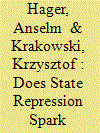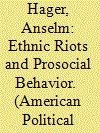| Srl | Item |
| 1 |
ID:
185020


|
|
|
|
|
| Summary/Abstract |
Does physical surveillance hinder or foster antiregime resistance? A common view holds that surveillance prevents resistance by providing regimes with high-quality intelligence on dissident networks and by instilling fear in citizens. We contrast this view using formerly classified data from Communist Poland. We find that communities exposed to secret police officers were more likely to organize protests but also engaged in less sabotage. To ensure that the relationship is causal, we use an instrumental variable strategy, which exploits the exogenous assignment of Catholic “spy priests” to local communities. To trace the underlying mechanisms, we draw on qualitative interviews and archival sources. We document that Poland’s comprehensive use of surveillance created widespread anger as well as an incentive for citizens to reveal their true loyalties, thus facilitating antiregime collective action. Once on the streets, protesters refrained from sabotage to signal their political motivation to bystanders and authorities alike.
|
|
|
|
|
|
|
|
|
|
|
|
|
|
|
|
| 2 |
ID:
168537


|
|
|
|
|
| Summary/Abstract |
Do ethnic riots affect prosocial behavior? A common view among scholars of ethnic violence is that riots increase cooperation within the warring groups, while cooperation across groups is reduced. We revisit this hypothesis by studying the aftermath of the 2010 Osh riot in Kyrgyzstan, which saw Kyrgyz from outside the city kill over 400 Uzbeks. We implement a representative survey, which includes unobtrusive experimental measures of prosocial behavior. Our causal identification strategy exploits variation in the distance of neighborhoods to armored military vehicles, which were instrumental in orchestrating the riot. We find that victimized neighborhoods show substantially lower levels of prosocial behavior. Importantly, we demonstrate that the reduction is similarly stark both within and across groups. Using qualitative interviews, we parse out two mechanisms that help explain the surprising reduction in ingroup prosociality: Victimized Uzbeks felt abandoned by their coethnics, and variation in victimization created a feeling of suspicion.
|
|
|
|
|
|
|
|
|
|
|
|
|
|
|
|
| 3 |
ID:
186699


|
|
|
|
|
| Summary/Abstract |
Many social movements face fierce resistance in the form of a countermovement. Therefore, when deciding to become politically active, a movement supporter has to consider both her own movement’s activity and that of the opponent. This paper studies the decision of a movement supporter to attend a protest when faced with a counterprotest. We implement two field experiments among supporters of a right- and left-leaning movement ahead of two protest–counterprotest interactions in Germany. Supporters were exposed to low or high official estimates about their own and the opposing group’s turnout. We find that the size of the opposing group has no effect on supporters’ protest intentions. However, as the own protest gets larger, supporters of the right-leaning movement become less while supporters of the left-leaning movement become more willing to protest. We argue that the difference is best explained by stronger social motives on the political left.
|
|
|
|
|
|
|
|
|
|
|
|
|
|
|
|